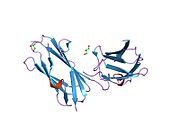FLNA
Ensembl | |||||||||
|---|---|---|---|---|---|---|---|---|---|
| UniProt | |||||||||
| RefSeq (mRNA) | |||||||||
| RefSeq (protein) | |||||||||
| Location (UCSC) | Chr X: 154.35 – 154.37 Mb | Chr X: 73.27 – 73.29 Mb | |||||||
| PubMed search | [3] | [4] | |||||||
| View/Edit Human | View/Edit Mouse |
Filamin A, alpha (FLNA) is a protein that in humans is encoded by the FLNA gene.[5][6]
Function
Actin-binding protein, or
Structure
The protein structure includes an actin binding N terminal domain, 24 internal repeats and 2 hinge regions.[9][10]
Interactions
Filamin has been shown to
RNA editing
The edited residue was previously recorded as a single nucleotide polymorphism(SNP) in dbSNP.
Type
A to I RNA editing is catalyzed by a family of adenosine deaminases acting on RNA (ADARs) that specifically recognize adenosines within double-stranded regions of pre-mRNAs and deaminate them to inosine. Inosines are recognised as guanosine by the cells translational machinery. There are three members of the ADAR family ADARs 1-3 with ADAR 1 and ADAR 2 being the only enzymatically active members.ADAR3 is thought to have a regulatory role in the brain. ADAR1 and ADAR 2 are widely expressed in tissues while ADAR 3 is restricted to the brain. The double stranded regions of RNA are formed by base-pairing between residues in a region complementary to the region of the editing site. This complementary region is usually found in a neighbouring intron but can also be located in an exonic sequence. The region that base pairs with the editing region is known as an Editing Complentary Sequence (ECS).
Site
The one editing site of FLNA pre-mRNA is located within amino acid 2341 of the final protein. The
Structure
The edited adenosine is located in the 22 immunogloulin[check spelling] like repeat of the protein. This region is an integrin β binding domain[27] and a RAC1 binding domain.[20] The amino acid change is likely to effect the electrostatic potential of the binding domains.[25] FLNA editing site is 2 nucleotides from a splice site like the R/G site of GluR-2. Both transcripts have 7/8 identical nucleotides around their editing sites. Since it is widely thought that editing at the GLUR-2 Q/R site influences splicing, the sequence and editing site similarity could mean that editing at the FLNA site could also regulate splicing. In vitro experiments of gluR-2 have shown that presence of ADAR2 results in inhibition of splicing.[28] Analysis of EST data for FLNA show that there is a link between editing of the last exon codon and retention of the following intron.[25]
Function
The change in electrostatic potential is likely to effect the binding of FLNA to the many proteins it interacts with.[29]
DNA repair
Interaction of FLNA with the BRCA1 protein is required for efficient regulation of early stages of DNA repair processes.[30] FLNA is implicated in the control of the DNA repair process of homologous recombination and non-homologous end joining.[30]
References
- ^ a b c GRCh38: Ensembl release 89: ENSG00000196924 – Ensembl, May 2017
- ^ a b c GRCm38: Ensembl release 89: ENSMUSG00000031328 – Ensembl, May 2017
- ^ "Human PubMed Reference:". National Center for Biotechnology Information, U.S. National Library of Medicine.
- ^ "Mouse PubMed Reference:". National Center for Biotechnology Information, U.S. National Library of Medicine.
- PMID 8406501.
- PMID 12612583.
- ^ "Entrez Gene: FLNA filamin A, alpha (actin binding protein 280)".
- PMID 31819097.
- PMID 2316.
- ^ "P21333 (FLNA_HUMAN): Filamin-A". UniProt.
- PMID 11602572.
- PMID 11807098.
- PMID 9722563.
- PMID 11390380.
- PMID 11390379.
- PMID 12679033.
- S2CID 4795393.
- PMID 12393796.
- PMID 12006559.
- ^ PMID 10051605.
- PMID 11163396.
- S2CID 10182923.
- PMID 8674032.
- PMID 12169691.
- ^ PMID 15731336.
- PMID 18430892.
- PMID 15225631.
- PMID 12592005.
- PMID 15364587.
- ^ a b Velkova A, Carvalho MA, Johnson JO, Tavtigian SV, Monteiro AN. Identification of Filamin A as a BRCA1-interacting protein required for efficient DNA repair. Cell Cycle. 2010 Apr 1;9(7):1421-33. doi: 10.4161/cc.9.7.11256. Epub 2010 Apr 1. PMID: 20305393; PMCID: PMC3040726
Further reading
- Light S, Sagit R, Ithychanda SS, Qin J, Elofsson A (Sep 2012). "The evolution of filamin - a protein domain repeat perspective". Journal of Structural Biology. 179 (3): 289–98. PMID 22414427.
- Stossel TP, Condeelis J, Cooley L, Hartwig JH, Noegel A, Schleicher M, Shapiro SS (2001). "Filamins as integrators of cell mechanics and signalling". Nat. Rev. Mol. Cell Biol. 2 (2): 138–45. S2CID 5203942.
- van der Flier A, Sonnenberg A (2001). "Structural and functional aspects of filamins". Biochim. Biophys. Acta. 1538 (2–3): 99–117. PMID 11336782.



